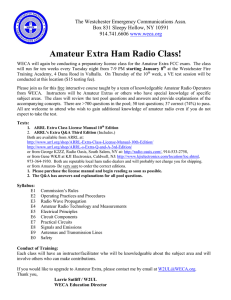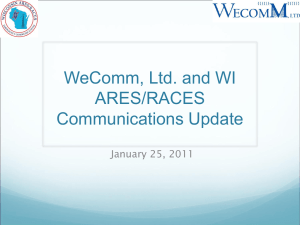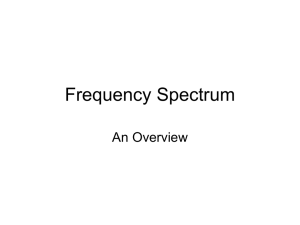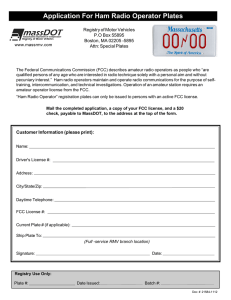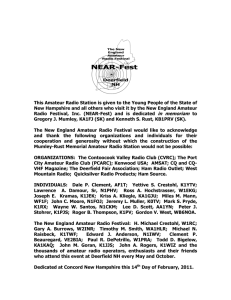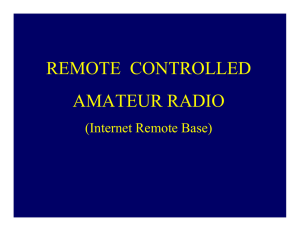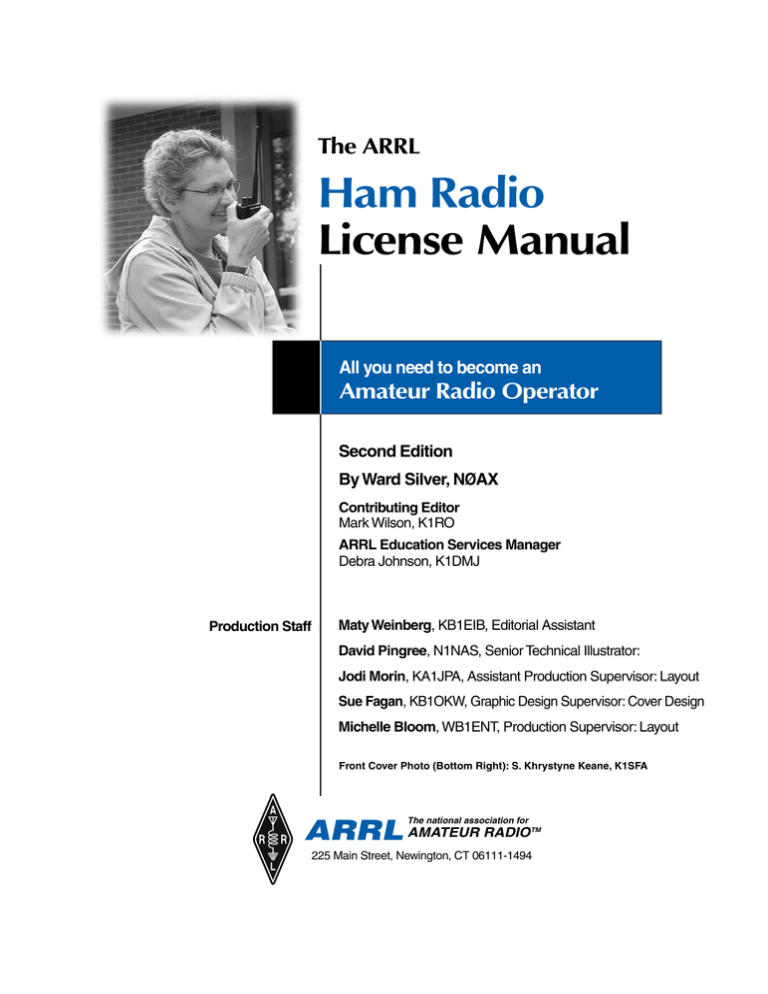
The ARRL
Ham Radio
License Manual
All you need to become an
Amateur Radio Operator
Second Edition
By Ward Silver, NØAX
Contributing Editor
Mark Wilson, K1RO
ARRL Education Services Manager
Debra Johnson, K1DMJ
Production Staff
Maty Weinberg, KB1EIB, Editorial Assistant
David Pingree, N1NAS, Senior Technical Illustrator:
Jodi Morin, KA1JPA, Assistant Production Supervisor: Layout
Sue Fagan, KB1OKW, Graphic Design Supervisor: Cover Design
Michelle Bloom, WB1ENT, Production Supervisor: Layout
Front Cover Photo (Bottom Right): S. Khrystyne Keane, K1SFA
ARRL AMATEUR RADIO
The national association for
TM
225 Main Street, Newington, CT 06111-1494
i
Copyright © 2010 by
The American Radio Relay League, Inc
Copyright secured under the Pan-American
Convention
All rights reserved. No part of this work may
be reproduced in any form except by written
permission of the publisher.
All rights of translation are reserved.
Printed in USA
Quedan reservados todos los derechos
ISBN10: 0-87259-083-6
ISBN13: 978-0-87259-083-0
Second Edition
First Printing
This book may be used for Technician license exams given
beginning July 1, 2010.
QST and the ARRL Web site (www.arrl.org) will have news
about any rules changes affecting the Technician class license
or any of the material in this book.
We strive to produce books without errors. Sometimes
­mistakes do occur, however. When we become aware of
­problems in our books (other than obvious typographical
­errors), we post corrections on the ARRL Web site. If you
think you have found an error, please check www.arrl.org/
ham-radio-license-manual for corrections. If you don’t find
a correction there, please let us know, either using the
­Feedback Form at the back of this book or by sending
e-mail to pubsfdbk@arrl.org.
ii
Chapter 1
Contents
Welcome to
Amateur Radio
Foreword
When to Expect New Books
The Adventure Begins
Your Invitation to ARRL Membership
How to Use this Book
1 Welcome to Amateur Radio
1.1
What is Amateur Radio?
1.2
The FCC and Licensing
1.3
Amateur Radio Activities
1.4
Getting Your Ham Radio License
1-1
1-12
1-14
1-19
2 Radio and Signals Fundamentals
2.1
Radio Signals and Waves
2.2
Modulation
2.3
Radio Equipment Basics
2-1
2-6
2-11
3 Electricity, Components, and Circuits
3.1
Electricity
3.2
Components and Units
3.3
Types of Radios and Radio Circuits
3-1
3-6
3-15
4 Propagation, Antennas, and Feed Lines
4.1
Propagation
4.2
Antenna Fundamentals
4.3
Feed Lines and SWR
4.4
Practical Antenna Systems
4-1
4-5
4-8
4-11
5 Amateur Radio Equipment
5.1
Transmitters and Receivers
5.2
Digital Communications
5.3
Power Supplies and Batteries
5.4
RF Interference (RFI)
5.5
RF Grounding
5-1
5-8
5-14
5-18
5-23
iii
6 Communicating With Other Hams
6.1
Contact Basics
6.2
Band Plans
6.3
Making Contacts
6.4
Using Repeaters
6.5
Nets
6.6
Emergency Communications
6.7
Special Activities, Modes and Techniques
6-1
6-9
6-11
6-15
6-20
6-24
6-29
7 Licensing Regulations
7.1
Licensing Terms
7.2
Working with the FCC
7.3
Bands and Privileges
7.4
International Rules
7.5
Call Signs
7-1
7-9
7-10
7-16
7-18
8 Operating Regulations
8.1
Control Operators
8.2
Identification
8.3
Interference
8.4
Third-Party Communications
8.5
Remote and Automatic Operation
8.6
Prohibited Transmissions
8-1
8-3
8-6
8-8
8-10
8-11
9 Safety
9.1
9.2
9.3
9-1
9-5
9-11
Electrical Safety
RF Exposure
Mechanical Safety
10 Glossary
11 Technician Class Exam Question Pool
Syllabus
Subelement T1 – FCC Rules
Subelement T2 – Operating Procedures
Subelement T3 – Radio Waves
Subelement T4 – Amateur Radio Practices
Subelement T5 – Electrical Principles
Subelement T6 – Electrical Components
Subelement T7 – Station Equipment
Subelement T8 – Operating Activities and Modes
Subelement T9 – Antennas & Feed Lines
Subelement T0 – Safety
Supplement — Choosing a Ham Radio
Amateur Radio Vendor Advertisements
iv
11-1
11-3
11-15
11-21
11-27
11-31
11-39
11-48
11-58
11-66
11-70
Foreword
Welcome to the diverse group of individuals who make up Amateur Radio! There are nearly 700,000 amateurs, or “hams,”
in the United States alone and 3,000,000 around the world. Hams come from all walks of life, all ages and every continent.
Hams are busily communicating without regard to the geographic and political barriers that often separate humanity. This
is the power of Amateur Radio — to communicate with each other directly, without any other commercial or government
systems.
Amateur Radio was born along with radio itself. Marconi, the father of radio, considered himself “an amateur” and many
of the wireless technologies and systems we take for granted today had their origins in the workshops and imaginations of
amateurs. Governments make room for Amateur Radio when valuable radio spectrum is allocated because they know and
respect the flexibility and inventiveness of hams, as well as the amateur’s legendary ability to innovate and adapt in the face
of emergencies and disasters.
Hams came to Amateur Radio from many walks of life and many interests. Perhaps you intend to provide emergency
communications for yourself and your community. Technical experimentation might be your interest or you might be one
of the burgeoning “do-it-yourself” community, discovering the pleasures of building, testing, using and learning. Making
new friends via the radio, keeping in touch as you travel or exploring where a wireless signal can take you — these are all
valuable and valued parts of the Amateur service.
A time-honored ham tradition is that of helping newcomers learn about the ways and skills of Amateur Radio. These
helpers — known as “Elmers” by other hams — are everywhere. You are almost certainly near another ham and probably
an entire ham radio club! They’ll gladly help you get started. There’s more information in Chapter 1 about connecting with
them. If you need assistance, the staff here at ARRL Headquarters will be more than happy to help, too.
As you read this book, getting ready to pass your first ham radio licensing exam, you will find that there is a lot more
material than just the answers to exam questions. That’s the ARRL way of going the extra mile to help you learn about
Amateur Radio. “Of, By and For the Amateur” is the ARRL’s motto. By providing this extra information, we help you learn
the “why” behind each question so that you are prepared when ready to get on the air. Keep this book handy as a reference
to help you understand how ham radio “works” and you’ll have more fun and be a more effective operator.
Most active radio amateurs in the United States are ARRL members. They realize that since 1914, the ARRL’s training,
sponsorship of activities and representation both nationally and internationally are second to none. The book you’re reading now, The ARRL Ham Radio License Manual is just one of many publications for all levels and interests in Amateur
Radio. You don’t need a license to join the ARRL — just be interested in Amateur Radio and we are interested in you. It’s
as simple as that!
David Sumner, K1ZZ
Chief Executive Officer
Newington, Connecticut
March 2010
New Ham Desk
ARRL Headquarters
225 Main Street
Newington, CT 06111-1494
(860) 594-0200
Prospective new amateurs call:
800-32-NEW-HAM (800-326-3942)
You can also contact us via e-mail: newham@arrl.org
or check out ARRLWeb: www.arrl.org
v
The Adventure Begins!
Congratulations! You’ve taken your first step into a hobby—and a service—that knows
no limits. ­Amateur Radio is a worldwide network of people from various ­cultures,
united by a common love of wireless com­­munication. ­Amateur Radio is as old as
radio itself, and its future is no less ­fantastic than its past.
For most people, Amateur ­Radio is a lifelong pursuit. We want to make sure you
get a good start, which is why we’ve published this book. But first, who are “we” ?
ARRL
The National Association for Amateur Radio: What’s in it for You?
Operating Awards: Like to collect “wallpaper”? The
ARRL sponsors a wide variety of certificates and Amateur Radio
achievement awards. For information on awards you can qualify
for, contact the ­Membership Services Department at HQ.
Help for New Hams: Are you a beginning ham looking
for help in getting started? The hams at ARRL HQ in Newington,
Connecticut, will be glad to assist you. Call 800-32-NEWHAM.
ARRL maintains a computer data base of ham clubs and ham
radio “helpers” from across the country who’ve told us they’re
interested in helping beginning hams. There are probably several
clubs in your area! Contact us for more information.
Equipment Insurance: Insurance is available to protect
you from loss or damage to your amateur station, antennas and
mobile equipment by lightening, theft, accident, fire, flood, tornado
and other natural disasters.
Licensing Classes: If you’re going to become a ham,
you’ll need to find a local license exam opportunity sooner or later.
ARRL Registered Instructors teach licensing classes all around
the country, and ARRL-sponsored Volunteer Examiners are right
there to administer your exams. To find the locations and dates of
Amateur Radio ­Licensing classes and test sessions in your area,
call the New Ham Desk at 800-32-NEWHAM.
Amateur Radio Emergency Service: If you’re interested in providing public ­service and emergency communications
for your community, you can join more than 25,000 other hams
who have registered their communications capabilities with local Emergency Coordinators. Your EC will call on you and other
ARES members for vital assistance if disaster should strike your
community. Contact the Field Services Department at HQ for
information.
Clubs: As a beginning ham, one of the best moves you
can make is to join a local ham club. Whether you join an allaround group or a special-interest club (repeaters, DXing, and
so on), you’ll make new friends, have a lot of fun, and you can
tap into a ready reserve of ham radio knowledge and experience.
To find the ham clubs in your area, call HQ’s New Ham Desk at
800-32-NEWHAM.
With your membership you also receive the monthly journal QST, the source for ham radio information, clever technical
tips, equipment reviews, projects, Public Service, Happenings
and more.
The ARRL also publishes newsletters and dozens of books
covering all aspects of ­Amateur Radio. Our Headquarters station,
W1AW, transmits bulletins of ­interest to ­radio amateurs and Morse
Code practice sessions.
Technical Information Service: Do you have a question
of a technical nature? (What new ham doesn’t?) Contact the Technical Information Service (TIS) at HQ. Our resident technical experts
will help you over the phone, send you specific information on your
question (antennas, interference and so on) or refer you to your
local ARRL Technical Coordinator or Technical Specialist. It’s
expert information—and it doesn’t cost Members an extra cent!
When it comes to representing Amateur Radio’s best interests in our nation’s capital, ARRL’s team in Washington, DC, is
­constantly working with the FCC, Congress and industry to protect
and foster your privileges as a ham operator.
Regulatory Information: Need help with a thorny antenna
zoning problem? ­Having trouble understanding an FCC regulation? Vacationing in a faraway place and want to know how to
get permission to operate your ham radio there? HQ’s Regulatory
Information Branch has the answers you need!
Regardless of your Amateur Radio interests, ARRL Membership is relevant and important. We will be happy to welcome
you as a Member. Use the Invitation to Membership in this book
to join today. And don’t hesitate to contact us if you have any
questions!
vi
When to Expect New Books
A Question Pool Committee (QPC) consisting of representatives from the various Volunteer Examiner
Coordinators (VECs) prepares the license question pools. The QPC establishes a schedule for revising
and implementing new Question Pools. The current Question Pool revision schedule is as follows:
Question Pool
Technician (Element 2)
Current Study Guides
The ARRL Ham Radio License Manual, 2nd edition
ARRL’s Tech Q&A, 5th Edition
Valid Through
June 30, 2014
General
(Element 3)
The ARRL General Class License Manual, 6th edition
ARRL’s General Q&A, 3rd Edition
June 30, 2011
Amateur Extra
(Element 4)
The ARRL Extra Class License Manual, 9th edition
ARRL’s Extra Q&A, 2nd Edition
June 30, 2012
As new question pools are released, ARRL will produce new study materials before the effective date
of the new Pools. Until then, the current Question Pools will remain in use, and current ARRL study
materials, including this book, will help you prepare for your exam.
As the new Question Pool schedules are confirmed, the information will be published in QST and on the
ARRL Web site at www.arrl.org.
viii
How to Use this Book
The ARRL Ham Radio License Manual is designed to
help you learn about every topic in the Technician exam
question pool. Every page presents information you’ll need
to pass the exam and become an effective operator. This book
goes well beyond the answers to exam questions — it also
contains explanations, guidelines and information to help you
remember and use what you learn on the air.
The book is organized to help you learn about radio
and operating in easy-to-understand, bite-sized steps. You’ll
begin by learning about the basics of radio signals and simple
ham radio equipment. The next steps cover the principles
of electricity and an introduction to electrical components.
You’ll then learn how a simple station is assembled and some
basic operating procedures. At that point, you’ll be ready to
understand the rules and regulations of ham radio. The final
section is all about ham radio safety.
At the back of this book you’ll also find a large glossary
of ham radio words, a supplement to help you choose a radio
and a selection of advertisements from some vendors of ham
radio equipment and supplies.
Conventions
Throughout your studies keep a sharp eye out for words
in italics. These words are important so be sure you understand
them. Many of them are included in the glossary. Another
thing to look for is the Web mouse symbol, indicating that
there is supplemental information on the Ham Radio License
Manual Web site (www.arrl.org/ham-radio-license-manual) to accelerate and broaden your understanding. If a Web
or email address is included, it will be printed in boldface
type.
As you read the book, you will see question designators
in square brackets, such as [T1A01]. These are
references to the question ID in the exam’s question pool. This will help you find the material
that addresses a specific question. The question
pool also includes a page reference where each
topic is discussed.
The Exam Question Pool
The complete Technician exam question pool is included
at the back of this book. The 35 questions you’ll answer on
the exam will be drawn from this question pool. Yes, these are
the actual questions on the exam, but resist the temptation to
just memorize the answers! Memorizing without learning the
subject is likely to leave you “high and dry” when you begin
using your new operating privileges. Do yourself a favor and
take the time to understand the material.
A Study Guide version of the question pool has been
prepared by the ARRL in which each question is presented in
the order it is covered in this book. The Study Guide version
can be downloaded from the Ham Radio License Manual
Web site.
When using the question pool for exam practice, each
question also includes a cross-reference back to the page of
the book covering that topic. If you don’t completely understand the question or answer, please go back and review
that material.
Self-Study and Classroom Tips
For self-study students, the material in the book is designed to be studied in order from beginning to end. Read the
material and then test your understanding by answering the
questions at the end of each section. Use the supplemental
material on the Ham Radio License Manual Web site if you
need extra help.
The ARRL’s New Ham Desk can answer questions
emailed to newham@arrl.org. Your question may be answered directly or you might be directed to more instruction
material. The New Ham Desk can also help you find a local ham to answer questions. Studying with a friend makes
learning the material more fun as you help each other over
the rough spots and you’ll have someone to celebrate with
after passing the exam!
If you are taking a licensing class, the instructors will
guide you through the material. Help your instructors by
letting them know where you need more assistance. They
want you to learn as thoroughly and quickly as possible, so
don’t hold back your questions. Similarly, if you find their
explanations particularly clear or helpful, tell them that, so
it can be used in the next class!
At the end of each section is a short list of exam questions covered in that section. This is a good time to pause for
a short review session. Be sure you understand the material
by answering the questions before moving to the next section.
It is a lot easier to learn the material section-by-section than
by rushing ahead and you’ll remember it more clearly. For
a focused discussion on each exam question, pick up a copy
of the ARRL’s Tech Q&A. Every question is included with
the correct answer and a short explanation.
To make the best use of the on-line reference material:
Bookmark the Ham Radio License Manual Web site to
use as an on-line reference while you study.
Download the Study Guide version of the question pool
from the Web site.
The Ham Radio License Manual Web page lists other
resources organized by section and chapter to follow the book.
Browse these links for extra information about the topics in
this book.
ix
x
Chapter 1
Welcome to
Amateur Radio
In this chapter, you’ll
learn about:
• What makes Amateur
Radio unique
• Why the FCC makes the
rules
• What activities you’ll find
in Amateur Radio
• Where you can find other
hams
• The Technician license
— what it is and how to
get it
• Ready? Set? Go!
When you see the mouse,
you’ll find more information at
www.arrl.org/ham-radio-license-manual
Welcome to the Ham Radio License Manual, the most popular
introduction to Amateur Radio of all! In this study guide, not only
will you learn enough to pass your Technician license exam, you’ll
also learn what ham radio is all about and how to jump right in once
you’re ready to get on the air.
If you want to know more about amateur or “ham” radio before you
start preparing to get a license, you’ll find your answers in sections
beginning with “What Is Amateur Radio?” If you already know about
ham radio and are anxious to get started, you’re in good company —
there are thousands of other folks getting ready to become a “ham” radio operator. Jump ahead to section 1.4 — “Getting Your Ham Radio
License” and get started!
1.1 What is Amateur Radio?
Amateur Radio will surprise you
with all its different activities. If
you’ve encountered Amateur Radio
in a public service role, or if someone you know has a ham radio in
their home or car, then you already
have some ideas. Maybe you have
seen ham radio in a movie or read
about it in a book. Are you a part
of the growing “do-it-yourself”
community? If so, you’ll really
enjoy getting involved with one of
the most “hands-on” hobbies of all!
Amateur Radio is the most powerful
communications service available to
Jerry Clement, VE6AB demonstrates
that you don’t need much equipment
to make contacts through a ham
radio satellite.
Welcome to Amateur Radio 1-1
Who Made the “Ham”?
How did “amateur” become “ham”?
The real answer is unknown! Even
before radio, telegraphers referred to
a poor operator as a ham. Perhaps
this was derived from a poor operator
being “ham-fisted” on the telegraph
key — an operator’s “fist” referred to his
or her distinctive style over the wires.
With all radio stations sharing the
same radio spectrum in the early days,
commercial and military operators
would sometimes refer to amateurs
as hams when there was interference.
Regardless, amateurs adopted the
term as a badge of honor and proudly
refer to each other as “hams” today.
the private citizen anywhere on Earth — or even above it!
Amateur Radio is a recognized national asset, providing
trained operators, technical specialists and emergency communications in time of need. It was created to give a home to
people just like you who have an interest in radio communications. Some hams prefer to focus on the technology and science
of radio. Competitive events and award programs hold the interest of others. Some train to use radio in support of emergency
relief efforts or to keep in touch with family. There are many
hams who just like to talk with other hams, too! This introductory section of the Ham Radio License Manual will give you a
broad overview of Amateur Radio so you can understand how
radio works and why hams do what they do. Let’s start at the
beginning, shall we?
BEGINNINGS OF HAM RADIO
Amateur Radio has been around since the beginning of radio
communications. It wasn’t long after Marconi spanned the Atlantic in 1901 before curious folks began experimenting with “wireless.”
Amateur Radio more or less invented itself, right along with broadcasting and wireless telegraphy. The very first amateur licenses were granted
back in 1912 and the number of “hams” grew rapidly. Early stations
used “spark,” literally a vigorous and noisy electrical arc, to generate
radio waves. Inefficient and hazardous, spark was soon replaced by far
more effective vacuum tube transmitters. By the end of the 1920s both
voice and Morse code could be heard on the airwaves. Radio became
very popular, instantly connecting communities and individuals as they
had never been before.
As radio communication became widespread, the Federal CommuniPaul Dallavia, KCØWDQ, prepares
cations Commission (FCC) was created to regulate the competing radio
for a training exercise with the
users, including broadcasters, commercial message and news services,
Arrowhead Amateur Radio Club of
military and public safety. The Amateur service (the legal name for
Duluth, Minnesota.
Amateur Radio) was created in 1934 and has expanded in size and
capability ever since. Amateurs, skilled in the ways of radio, played crucial roles during
World War II as operators and radio engineers.
After the war, thousands of hams turned to radio and electronics as a profession, fueling
the rapid advances in communications during the 1950s and 60s. Amateur Radio evolved
right along with industry — spanning the globe was commonplace! With Morse code as
An On-Line Mentor
The ARRL’s Ham Radio License Manual (HRLM) Web page www.arrl.org/ham-radio-license-manual
contains useful additional or tutorial information organized in the same way as this book. There are also links
to other Web resources that provide more detail about the book’s topics. Look for the mouse symbol in the
margin of the text — it indicates that there is more information on the HRLM Web site to help you.
The HRLM Web site also provides in-depth guidance on technical topics. For example, if you need help
with your math skills, there are links to online math tutorials and articles. For the handful of exam
questions that involve calculations, the Web page shows exactly how to work out each problem.
The Web page also includes helpful links for finding licensing classes, study materials,
background information, asking questions and more. You’ll find it a good introduction to the
ARRL Web site, the most complete and resource for amateurs in the world.
1-2 Chapter 1
popular as ever, the amateur
airwaves were also filling
with voice and radioteletype
signals. Hams even invented a new form of picture
transmission called slowscan television that could be
performed with regular voice
equipment. The first satellite built by amateurs, called
OSCAR-1, was launched in
1961, transmitting a simple
Morse message back to
Earth for several weeks.
Through the 1970s
amateurs built an extensive
network of relay “repeater”
stations, providing regional
communications with lowpower mobile and handheld
Hams have been building “OSCAR” satellites, such as AO-51 shown in
radios. In the 1980s and
this photo, for decades. OSCAR stands for Orbiting Satellite Carrying
1990s, microprocessors
Amateur Radio. The first OSCAR was launched in 1961!
were quickly applied to
radio, greatly increasing
the capabilities of amateur
equipment and ushering in
That’s Why It’s Called “Amateur” Radio
a new era of digital communications. Packet radio,
In order to keep businesses or municipalities from unfairly exploiting
an adaptation of computer
the amateur bands, amateurs are strictly forbidden from receiving
compensation for their activities. That means you can’t talk with a conetworks, was developed
worker about an assignment, for example. If you provide communicaby hams and is now widely
tions for a parade or charity activity, you can’t accept a fee. This keeps
used for commercial and
Amateur Radio free to explore and improve and train. It’s worked well
public safety.
for many years!
The personal computer,
as in many other fields,
gave amateurs a powerful
new tool for design, modeling, station automation and recordkeeping, as well as making
Amateur Radio computer networks a reality. Finally, the Internet arrived and hams quickly
adapted the new technology to their own uses just as they had many times before. At each
step in the development of today’s communication-intensive world, hams have contributed
either as part of their profession or as individuals pursuing a personal passion.
HAM RADIO TODAY
Here we are a century later and wireless is still very much at the forefront of communications technology. Far from being eclipsed by the Internet, ham radio continues its tradition
of innovation by combining the Internet with radio technologies in new ways. Hams have
created their own wireless data networks, position reporting systems, and even a radiobased email network that enables the most solitary ham to “log in” from anywhere in the
world. Voice communications hop between Internet and radio links to connect hams on the
opposite sides of the globe using only handheld transmitters less powerful than a flashlight!
Don’t let anyone tell you that Morse code is finished! It’s still very much alive in
Welcome to Amateur Radio 1-3
The Goldfarb Scholarship
winner for 2009 was Dean
LaBarba, KI6CUX, who
is part of the only high
school Amateur Radio
Emergency Service team
in Long Beach, California.
Former Youth Editors Brian Mileshosky, N5ZGT (left),
and Andrea Hartlage, KG4IUM meet current ARRL Youth
Editor Duncan MacLachlan, KUØDM at the 2009 Dayton
Hamvention. Brian is now the ARRL Rocky Mountain
Division Director.
Christopher Palm, KC9JTL, and dad
David, W9HQ, entered their first-ever
VHF contest and earned fifth place
Limited Multioperator honors in the
Central Division.
Gabrielle Kaili-May
Liu, KJ4MXC, passed
her Technician exam
in second grade,
shown receiving
her Certificate of
Successful Completion
of Examination (CSCE)
from Volunteer Examiner
Butch Smith, N4TK.
Amateur Radio where its simplicity and efficiency continue to make it popular. Amateurs
also speak to each other directly using sophisticated radios that are grown-up versions
of the Citizen’s Band (CB) and Family Radio Service (FRS) radios available at the local
electronics stores. Computers are a big part of ham radio today as hams chat “keyboard-tokeyboard” or send pictures via radio. You’ll even find some hams assembling their own TV
stations and transmitting professional-quality video!
In step with the telecommunications industry, hams also look to the skies for their communications. There are more than a dozen active Amateur Radio satellites whirling through
orbit, connecting hams on the ground by voice, Morse code and data signals. There is even
a ham station on the International Space Station used by astronauts (most astronauts have
ham licenses) and ground-based hams alike. Ham-written software allows signals to be
bounced off the moon and even meteor trails in the Earth’s atmosphere.
When disaster strikes, you find hams responding quickly and capably in support of public
safety agencies and relief organizations such as the Red Cross. Amateur Radio is an important
part of many disaster relief efforts. Between emergencies, hams turn out in great numbers to
provide communications for parades, sporting events, festivals and other public occasions.
While Amateur Radio got its start long ago as a collection of tinkerers in basements
and backyard “shacks,” it has grown to become a worldwide communications service for
millions of licensees. The tinkerers are very much still with us, of course, creating new and
1-4 Chapter 1

